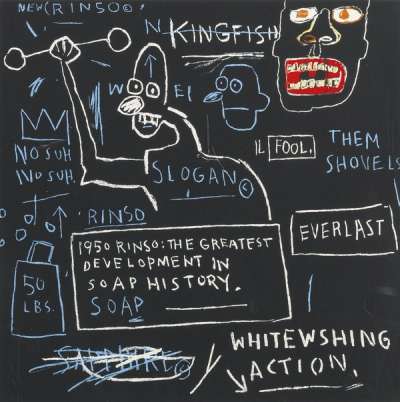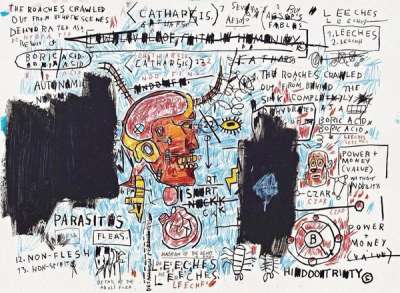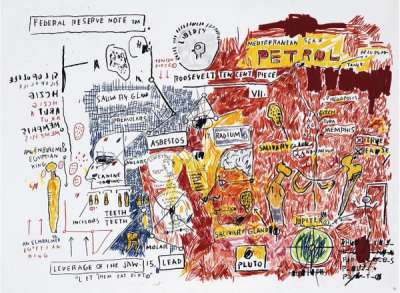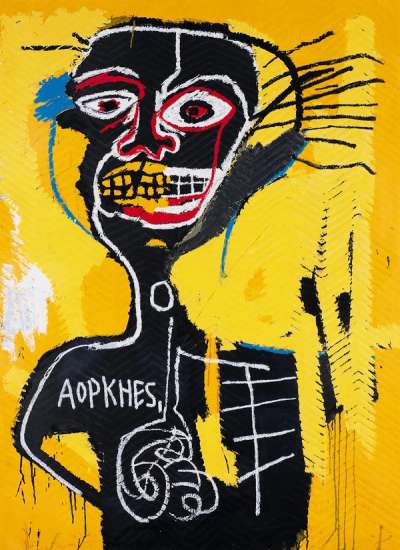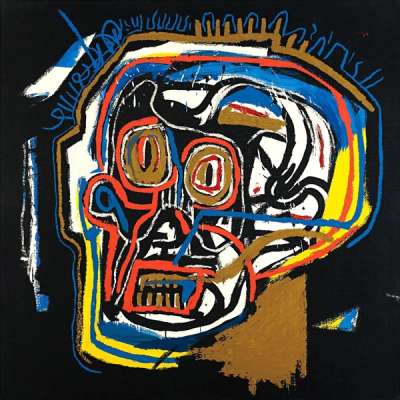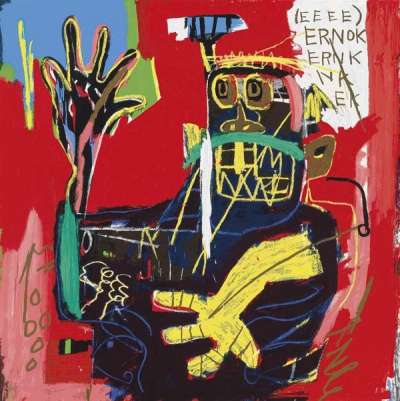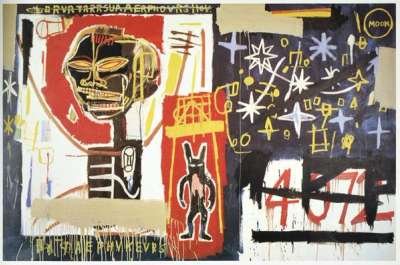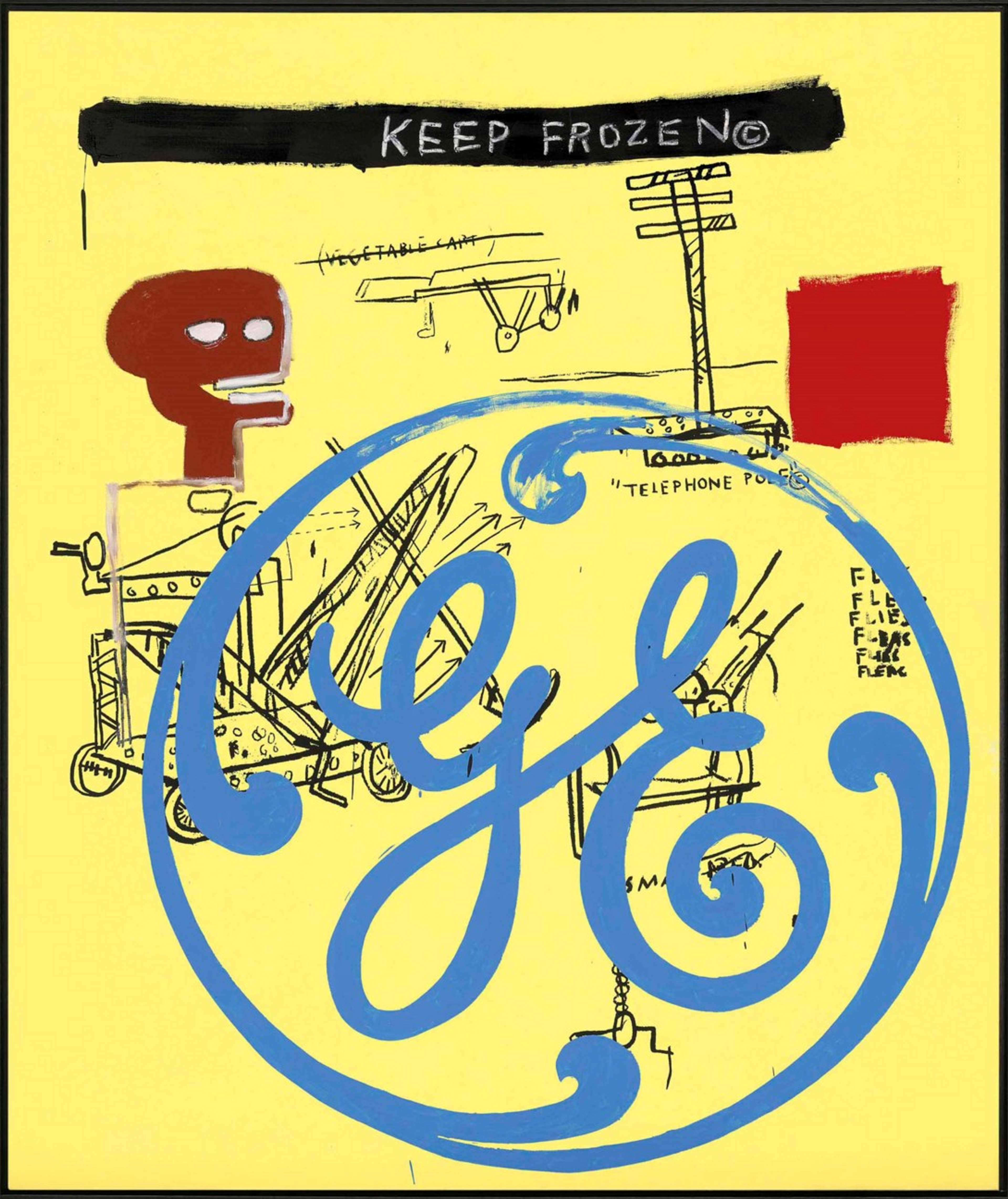Jean-Michel Basquiat's Artistic Process: From Concept to Creation

 Undiscovered Genius © Jean-Michel Basquiat 1983
Undiscovered Genius © Jean-Michel Basquiat 1983
Interested in buying or selling
Jean-Michel Basquiat?

Jean-Michel Basquiat
56 works
Key Takeaways
Jean-Michel Basquiat's artistic process was deeply influenced by his personal experiences, cultural heritage, and the social issues of his time. Drawing inspiration from his Haitian and Puerto Rican roots, as well as the gritty energy of New York City's urban landscape, Basquiat created raw, expressive works that combined text, symbols, and layered imagery. His process was organic, beginning with spontaneous sketches and evolving through dynamic layering techniques that conveyed complex narratives about race, identity, and power.
Jean-Michel Basquiat, a prodigious talent who emerged from the streets of New York City, is celebrated for his raw, expressive artworks that challenge societal norms and offer profound commentary on race, identity, and power. Basquiat’s creative process centred around his personal experiences, the cultural and creative fabric of New York’s urban landscape, and his experience as a young black artist operating within a predominantly white art world.
His influence on contemporary art is immeasurable, shaping the visual language of the 1980s through his distinctive Neo-Expressionism and graffiti-infused style, and encouraging artists to use their work as expressions of self-identity.
Inspiration and Conceptualisation
Sources of Inspiration
Basquiat's artistic process is inspired by his personal experiences, cultural heritage, and acute awareness of societal issues. Growing up in a diverse cultural milieu, his Haitian and Puerto Rican heritage played a significant role in shaping his worldview. His works are imbued with references to African and Caribbean cultures and historical iconography. Basquiat used these references to highlight pertinent social issues, particularly struggles of racial inequality and the erasure of artistry amongst African Americans. This is most explicitly seen in works such as Undiscovered Genius (1983) and Hollywood Africans (1983).
Basquiat’s prolific use of symbols, particularly skeletons and skulls, articulated his concerns surrounding violence and mortality. A car accident as a child resulted in Basquiat spending a considerable amount of time in hospital, during which his mother gifted him a copy of Gray’s Anatomy (1858). This encyclopaedia on human anatomy left the young Basquiat with a fascination for the anatomical form, and this influence is reflected throughout his oeuvre.
Additionally, the chaotic energy and gritty realities of New York City, particularly the Lower East Side and its burgeoning graffiti scene, fueled Basquiat’s artistic vision. His early involvement in the graffiti project SAMO©, and his artistic circle including street artists Al Diaz and Rammellzee, resulted in his artworks containing district graffiti-inspired techniques. Furthermore, Basquiat drew unique inspiration from New York’s vibrant and diverse cultural scene, integrating prominent jazz musicians and sportsmen into his pieces.
Idea Development
Basquiat's process of brainstorming and developing concepts was organic and spontaneous. He was known for carrying sketchbooks and often noted ideas; snippets of conversations or quick sketches that later evolved into complex artworks. These sketchbooks were a crucial part of his creative arsenal, serving as repositories of thoughts and visual experiments that he could revisit and develop further.
 Odours of Punt © Jean-Michel Basquiat 2024
Odours of Punt © Jean-Michel Basquiat 2024Preparation and Materials
Choosing the Right Materials
Basquiat had a distinctive approach to materials, often using a combination of traditional and unconventional media. He worked on various surfaces, including canvas, paper, and objects like doors, windows, and pieces of furniture. He also used a variety of mediums, including spray paint, acrylic, crayon and even human hair, seen on his performance piece Untitled (Football Helmet) (1981). This eclectic choice of materials added a unique texture and depth to his works, reflecting his innovative spirit and the urban environment he inhabited.
Creating the Artwork
Initial Sketches and Layout
Basquiat typically began his pieces with quick sketches and preliminary layouts. These initial drawings helped him map out the composition and establish the foundational structure of the artwork. His sketches were often loose and gestural, capturing the raw energy and emotion that he would later expand upon.
Building Layers
Layering was a fundamental technique in Basquiat's work, creating depth and complexity. He built his pieces in multiple stages, adding layers of paint, paper, symbols, and textual elements. This approach allowed him to juxtapose different textures and imagery, creating a rich, multi-dimensional effect and showcasing his background in street art and graffiti techniques. Intentionally contrasting layers not only added depth, but also served as metaphors for the complexity of the issues he was highlighting through his works. The layers were not just a fundamental technique, they revealed the levels of meaning behind each piece, and encouraged his viewers to participate in more introspective meditations. Notable works of Basquiat that showcase his layering technique include Bird On Money (1981), Erocia (1987) and Olympic (1983).
Incorporation of Text and Symbols
Text and symbols are integral to Basquiat's work, serving as both visual elements and conveyors of meaning. His engagement with graffiti during his teenage years marked his later artistic interest in uniting text and imagery in his compositions. Basquiat frequently integrated text into his pieces, obscuring certain words in order to draw more attention to issues he wanted to highlight. Basquiat revealed; “I cross out words so you will see them more; the fact that they are obscured makes you want to read them”. He seamlessly integrated words, phrases, and symbols into his compositions, using them to challenge the viewer and provoke thought. Basquiat was influenced by his passion for hip-hop, and incorporated the genre’s technique of breaking up and sampling different works to create a unique whole piece. This combination of text and imagery created a dynamic interplay that is both visually striking and intellectually engaging.
Techniques and Styles
Expressive Brushwork
Basquiat's brushwork is distinctive, characterised by bold, expressive lines and vigorous application of paint. His technique conveyed a sense of urgency and raw emotion, drawing the viewer into the intensity of his vision.
Use of Colour
Colour played a crucial role in Basquiat's art, used to convey expressionistic energy, highlight important elements, and create contrast. His colour palettes were often vibrant and bold, reflecting his dynamic personality and the diverse urban environment of the city. By experimenting with different colour combinations, he was able to evoke powerful emotional responses from his audience.
Influence of Collaborations and Interactions
Collaborations and interactions with other artists significantly influenced Basquiat's work. Studio visits and exchanges with contemporaries like Andy Warhol and Keith Haring sparked new ideas and pushed him to explore different approaches. Basquiat and Warhol’s collaborations are infamous, the two artists creating over 100 works together by layering their individual techniques onto one canvas, seen in pieces such as Bananas (1984-5) and Keep Frozen (General Electric) (1985). Warhol claims; “Jean-Michel got me into painting differently, so that's a good thing”, and both artists were inspired creatively by each other's innovation and contrasting techniques. Basquiat and Haring also became good friends, and both used their work to address issues of social inequality. Basquiat's raw intensity complemented Haring's pop-inspired imagery to create visually striking works.
 Image © Phillips / Bananas © Jean-Michel Basquiat and Andy Warhol 1984
Image © Phillips / Bananas © Jean-Michel Basquiat and Andy Warhol 1984Exhibition and Public Reception
Preparing for Exhibitions
Preparing for exhibitions involved selecting works that best represented Basquiat's vision and message. The presentation and curation of his pieces were crucial, as thoughtful curation helped highlight the thematic and stylistic elements of his art and influenced how the public and critics perceived his work.
Basquiat’s first exhibition was a public group show in a vacant Times Square building in 1980, which marked a turning point for Basquiat and led to his first solo exhibition in 1982, opened at the Fun Gallery in the East Village. Among the works exhibited were A Panel of Experts (1982) and Equals Pi (1982).
Reception and Critique
Basquiat's art was met with a varied reception during his lifetime and posthumously. Initially, his raw, graffiti-influenced style garnered mixed reactions; while some critics and audiences celebrated his originality and emotional intensity, others dismissed it as chaotic and lacking refinement.
Despite this, Basquiat quickly rose to prominence in the 1980s art scene, gaining the support of influential figures like Warhol, whose guidance and collaboration legitimised Basquiat’s work within the exclusive contemporary art scene of the 1980s. Over time, the appreciation for his work has grown substantially, his pieces recognised and admired for their profound commentary on social and cultural issues, and holding incredibly high market value.
The Legacy of Basquiat’s Artistic Process
Basquiat's journey from the streets of New York City to the apex of the contemporary art world is a testament to his extraordinary talent and innovative spirit. His creative process, deeply rooted in personal experiences and cultural heritage, combined with his acute awareness of societal issues, produced artworks that challenge, provoke, and inspire. His artistic process, from conceptualisation to intricate layering of paint, text and symbols, reveals the depth and complexity of his masterpieces. Basquiat's legacy is not only seen in his influence on contemporary art and his profound commentary on race and identity, but also in the way his process continues to inspire new generations of artists to explore their identities and challenge societal norms through their work.



